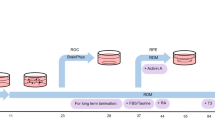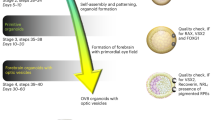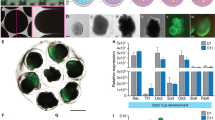Abstract
This protocol details organotypic cultures of developing mouse, monkey and human retinas, which can be maintained for up to 2 weeks. Intact retinas are placed on polycarbonate filters floating on explant culture medium and fed every day with previously prepared retinal conditioned medium. Developing mouse retinas from E12.5 to P12 have been successfully cultured using this protocol as well as retinas from the equivalent stages of human and monkey development. Although this protocol does not require any special equipment, it provides a relatively high throughput. Retinal explant cultures lend themselves to complex pharmacological and genetic manipulations that are currently not feasible in vivo. A detailed procedure for square wave electroporation of retinal explants is also included to provide a high-throughput means to alter gene expression in the developing retina. This protocol for the preparation of retinal conditioned explant medium requires 4 d. Other steps of this protocol can be completed in 2 h.
This is a preview of subscription content, access via your institution
Access options
Subscribe to this journal
Receive 12 print issues and online access
$259.00 per year
only $21.58 per issue
Buy this article
- Purchase on Springer Link
- Instant access to full article PDF
Prices may be subject to local taxes which are calculated during checkout




Similar content being viewed by others
References
Gahwiler, B.H. Organotypic cultures of neural tissue. Trends Neurosci. 11, 484–489 (1988).
Gahwiler, B.H., Capogna, M., Debanne, D., McKinney, R.A. & Thompson, S.M. Organotypic slice cultures: a technique has come of age. Trends Neurosci. 20, 471–477 (1997).
Seigel, G.M. The golden age of retinal cell culture. Mol. Vis. 5, 4 (1999).
Araki, M. Developmental potency of cultured pineal cells: an approach to pineal developmental biology. Microsc. Res. Tech. 53, 33–42 (2001).
Kasal, C.A., Menaker, M. & Perez-Polo, J.R. Circadian clock in culture: N-acetyltransferase activity of chick pineal glands oscillates in vitro. Science 203, 656–658 (1979).
Feigenspan, A., Bormann, J. & Wassle, H. Organotypic slice culture of the mammalian retina. Vis. Neurosci. 10, 203–217 (1993).
Ogilvie, J.M., Speck, J.D., Lett, J.M. & Fleming, T.T. A reliable method for organ culture of neonatal mouse retina with long-term survival. J. Neurosci. Methods 87, 57–65 (1999).
Sassoe-Pognetto, M., Feigenspan, A., Bormann, J. & Wassle, H. Synaptic organization of an organotypic slice culture of the mammalian retina. Vis. Neurosci. 13, 759–771 (1996).
Mears, A.J. et al. Nrl is required for rod photoreceptor development. Nat. Genet. 29, 447–452 (2001).
Dyer, M.A. et al. Retinal degeneration in Aipl1-deficient mice: a new genetic model of Leber congenital amaurosis. Brain Res. Mol. Brain Res. 132, 208–220 (2004).
Akhmedov, N.B. et al. A deletion in a photoreceptor-specific nuclear receptor mRNA causes retinal degeneration in the rd7 mouse. Proc. Natl. Acad. Sci. USA 97, 5551–5556 (2000).
Furukawa, T., Morrow, E.M., Li, T., Davis, F.C. & Cepko, C.L. Retinopathy and attenuated circadian entrainment in Crx-deficient mice. Nat. Genet. 23, 466–470 (1999).
Burmeister, M. et al. Ocular retardation mouse caused by Chx10 homeobox null allele: impaired retinal progenitor proliferation and bipolar cell differentiation. Nat. Genet. 12, 376–384 (1996).
Zhang, J. et al. Rb regulates proliferation and rod photoreceptor development in the mouse retina. Nat. Genet. 36, 351–360 (2004).
Clarke, A.R. et al. Requirement for a functional Rb-1 gene in murine development. Nature 359, 328–330 (1992).
Lee, E.Y. et al. Mice deficient for Rb are nonviable and show defects in neurogenesis and haematopoiesis. Nature 359, 288–294 (1992).
Jacks, T. et al. Effects of an Rb mutation in the mouse. Nature 359, 295–300 (1992).
Dyer, M.A. & Cepko, C.L. p57(Kip2) regulates progenitor cell proliferation and amacrine interneuron development in the mouse retina. Development 127, 3593–3605 (2000).
Morrow, E.M., Belliveau, M.J. & Cepko, C.L. Two phases of rod photoreceptor differentiation during rat retinal development. J. Neurosci. 18, 3738–3748 (1998).
Lillien, L. & Cepko, C. Control of proliferation in the retina: temporal changes in responsiveness to FGF and TGF alpha. Development 115, 253–266 (1992).
Donovan, S.L., Schweers, B., Martins, R., Johnson, D. & Dyer, M.A. Compensation by tumor suppressor genes during retinal development in mice and humans. BMC Biol. 4, 14 (2006).
Dyer, M.A. & Cepko, C.L. Control of Muller glial cell proliferation and activation following retinal injury. Nat. Neurosci. 3, 873–880 (2000).
Martins, R.A., Linden, R. & Dyer, M.A. Glutamate regulates retinal progenitors cells proliferation during development. Eur. J. Neurosci. 24, 969–980 (2006).
Sage, J., Miller, A.L., Perez-Mancera, P.A., Wysocki, J.M. & Jacks, T. Acute mutation of retinoblastoma gene function is sufficient for cell cycle re-entry. Nature 424, 223–228 (2003).
Laurie, N.A. et al. Inactivation of the p53 pathway in retinoblastoma. Nature 444, 61–66 (2006).
Altshuler, D., Lo Turco, J.J., Rush, J. & Cepko, C. Taurine promotes the differentiation of a vertebrate retinal cell type in vitro. Development 119, 1317–1328 (1993).
Alexiades, M.R. & Cepko, C. Quantitative analysis of proliferation and cell cycle length during development of the rat retina. Dev. Dyn. 205, 293–307 (1996).
Belliveau, M.J., Young, T.L. & Cepko, C.L. Late retinal progenitor cells show intrinsic limitations in the production of cell types and the kinetics of opsin synthesis. J. Neurosci. 20, 2247–2254 (2000).
Belliveau, M.J. & Cepko, C.L. Extrinsic and intrinsic factors control the genesis of amacrine and cone cells in the rat retina. Development 126, 555–566 (1999).
Morrow, E.M., Furukawa, T., Lee, J.E. & Cepko, C.L. NeuroD regulates multiple functions in the developing neural retina in rodent. Development 126, 23–36 (1999).
Alexiades, M.R. & Cepko, C.L. Subsets of retinal progenitors display temporally regulated and distinct biases in the fates of their progeny. Development 124, 1119–1131 (1997).
Ezzeddine, Z.D., Yang, X., DeChiara, T., Yancopoulos, G. & Cepko, C.L. Postmitotic cells fated to become rod photoreceptors can be respecified by CNTF treatment of the retina. Development 124, 1055–1067 (1997).
Guillemot, F. & Cepko, C.L. Retinal fate and ganglion cell differentiation are potentiated by acidic FGF in an in vitro assay of early retinal development. Development 114, 743–754 (1992).
Young, T.L. & Cepko, C.L. A role for ligand-gated ion channels in rod photoreceptor development. Neuron 41, 867–79 (2004).
Dyer, M.A. & Cepko, C.L. p27Kip1 and p57Kip2 regulate proliferation in distinct retinal progenitor cell populations. J. Neurosci. 21, 4259–4271 (2001).
Dyer, M.A., Livesey, F.J., Cepko, C.L. & Oliver, G. Prox1 function controls progenitor cell proliferation and horizontal cell genesis in the mammalian retina. Nat. Genet. 34, 53–58 (2003).
Matsuda, T. & Cepko, C.L. Electroporation and RNA interference in the rodent retina in vivo and in vitro. Proc. Natl. Acad. Sci. USA 101, 16–22 (2004).
Levine, E.M., Roelink, H., Turner, J. & Reh, T.A. Sonic hedgehog promotes rod photoreceptor differentiation in mammalian retinal cells in vitro. J. Neurosci. 17, 6277–6288 (1997).
Wang, Y., Dakubo, G.D., Thurig, S., Mazerolle, C.J. & Wallace, V.A. Retinal ganglion cell-derived sonic hedgehog locally controls proliferation and the timing of RGC development in the embryonic mouse retina. Development 132, 5103–5113 (2005).
Hicks, D., Heidinger, V., Mohand-Said, S., Sahel, J. & Dreyfus, H. Growth factors and gangliosides as neuroprotective agents in excitotoxicity and ischemia. Gen. Pharmacol. 30, 265–273 (1998).
LaVail, M.M. et al. Multiple growth factors, cytokines, and neurotrophins rescue photoreceptors from the damaging effects of constant light. Proc. Natl. Acad. Sci. USA 89, 11249–11253 (1992).
Abe, M. et al. Circadian rhythms in isolated brain regions. J. Neurosci. 22, 350–356 (2002).
Zhang, H. et al. Light-dependent redistribution of visual arrestins and transducin subunits in mice with defective phototransduction. Mol. Vis. 9, 231–237 (2003).
Saito, T. In vivo electroporation in the embryonic mouse central nervous system. Nat. Protoc. 1, 1552–1558 (2006).
Acknowledgements
This work was supported by grants (to M.A.D.) from the National Institutes of Health, Cancer Center Support from the National Cancer Institute, the American Cancer Society, Research to Prevent Blindness, the Pearle Vision Foundation, the International Retinal Research Foundation and the American Lebanese Syrian Associated Charities (ALSAC). M.A.D. is a Pew Scholar. This work was also supported by grants (to S.L.D.) from Fight for Sight and the Gerwin Fellowship Foundation.
Author information
Authors and Affiliations
Corresponding author
Ethics declarations
Competing interests
The authors declare no competing financial interests.
Supplementary information
Supplementary Video 1
Dissection of retinae from 6 P0 pups. (MOV 25438 kb)
Supplementary Video 2
Transfer immediately after dissection 3–4 dissected retinae with a small volume (50 μl) of culture medium to a membrane on the 12-well dish (1 retina per membrane) using a sterile disposable transfer pipette. (MOV 4650 kb)
Supplementary Video 3
Electroporation of dissected retina in the Petri dish electrode chamber. Transfer retina using a sterile disposable transfer pipette. (MOV 2781 kb)
Rights and permissions
About this article
Cite this article
Donovan, S., Dyer, M. Preparation and square wave electroporation of retinal explant cultures. Nat Protoc 1, 2710–2718 (2006). https://doi.org/10.1038/nprot.2006.454
Published:
Issue Date:
DOI: https://doi.org/10.1038/nprot.2006.454
This article is cited by
-
Neuronal migration prevents spatial competition in retinal morphogenesis
Nature (2023)
-
Live imaging of developing mouse retinal slices
Neural Development (2018)
-
Co-deleting Pten with Rb in retinal progenitor cells in mice results in fully penetrant bilateral retinoblastomas
Molecular Cancer (2015)
-
Live imaging and analysis of postnatal mouse retinal development
BMC Developmental Biology (2013)
Comments
By submitting a comment you agree to abide by our Terms and Community Guidelines. If you find something abusive or that does not comply with our terms or guidelines please flag it as inappropriate.



